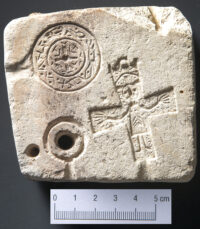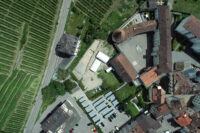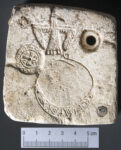 A salvage archaeology excavation in Chur, the capital of the Swiss canton of Grisons, have unearthed a stone jewelry mold and other evidence of a busy medieval artisan district. The molds was used to produce jewelry and religious objects. It is an extremely rare find, the first of its kind in the canton. The only comparable examples ever found in Switzerland were discovered far to the north and northwest of Grisons in Bern, Basel, and Winterthur.
A salvage archaeology excavation in Chur, the capital of the Swiss canton of Grisons, have unearthed a stone jewelry mold and other evidence of a busy medieval artisan district. The molds was used to produce jewelry and religious objects. It is an extremely rare find, the first of its kind in the canton. The only comparable examples ever found in Switzerland were discovered far to the north and northwest of Grisons in Bern, Basel, and Winterthur.
The uneven square measures 9 x 8.3 x 3 centimeters (3.5 x 3.3 x 1.2 inches). One side has two stamp matrices with Christian iconography — a crucifix and a circle with a cross in the center — that would have been used to make pendants, buckles, medallions. There is also a cavity that would have made a small hoop, likely for earrings. The other side of has another circle with a cross in the center, plus templates for an eagle and an annular brooch. It dates to between the 9th and 11th centuries.
 Archaeologists have been excavating the area near the former Sennhof penitentiary since March in advanced of a renovation. Two previous excavations in 1984 and 1990 discovered the remains of settlements and tombs that confirm the area was continuously inhabited from the late Bronze Age through the present. This year’s excavation has shed light on the medieval city.
Archaeologists have been excavating the area near the former Sennhof penitentiary since March in advanced of a renovation. Two previous excavations in 1984 and 1990 discovered the remains of settlements and tombs that confirm the area was continuously inhabited from the late Bronze Age through the present. This year’s excavation has shed light on the medieval city.
Currently an excavation team of the SAG is examining a south-east part of the built surface, where inconspicuous structures have been brought to light in the form of postholes, pits and tombs, as well as a significant use of stone paving. Particularly noteworthy are the high number and type of finds found. It is a large quantity of animal bones (mostly horses) and semi-finished products and carvers’ production waste. Among the objects there are also bars in non-ferrous metals, spindles, glass slag and similar fragments. From the combination of simple wooden constructions and finds in specific material, it can be assumed that the area served as a laboratory for various craft activities during the High and Low Middle Ages.
One of the oldest settlements in Switzerland, Chur prospered in the second half of the 10th century thanks to its location at the confluence of several Alpine trade routes and the Rhine. The local producers of highly portable jewelry, trinkets and other crafts had access to those markets.
 The jewelry mold is now undergoing thorough study and analysis for scientific publication. The objects discovered in the excavation are tentatively scheduled to go on public display in an exhibition, Commerce and Artisanship between the Lake of Constance and the Alpine Rhine, at the Chur museum in 2023.
The jewelry mold is now undergoing thorough study and analysis for scientific publication. The objects discovered in the excavation are tentatively scheduled to go on public display in an exhibition, Commerce and Artisanship between the Lake of Constance and the Alpine Rhine, at the Chur museum in 2023.